Brandon Carpenter 2006
Training is a term we have been conditioned to accept as done through tasks and by using tools. This is true, but sometimes the tools we use, we cannot see, taste, hear, smell or physically touch. If we cannot see or touch the tool how can we use it? The sense we employ to use this tool is feel. This feel is different however from the feel we traditionally experience through our fingers or skin.
Instead I am referring to the inner feeling that goes on inside our bodies to create an emotional and physical change in us. This feeling changes us as well as those we come in contact with. What does this have to do with training or even handling horses? A lot! It actually has more to do with training ourselves in order to work more effectively and subtly with horses.
What is sadness, joy, fear, aggression or any other feeling but an emotion within us? In short it is a state of being that we get a physical internal sensation from. This internal sensation influences our attitude, thoughts and physical demeanor. We have all heard the expressions “dead on my feet” or “my heart was in my throat”. What do those words describe? Obviously they aren’t literal terms, but terms to describe a feeling.
For most of us it conjures up a memory we can identify with when we felt a certain way. The feeling we got when we were so tired our energy was low and in our feet, or so scared about something our energy was in our throat. Energy is the key.
Energy is something for most of us that we know is there and available for us to consume every day. We consume it to light, heat or cool our homes, cook our meals, drive our cars, as well as thousands of other uses. We tend to think of energy as a tool for us to get what we want or need to sustain life. We purchase it from companies as a commodity every day.
There is also the type of energy that is not just a commodity, but is what makes us live as a biological unit in our very base form. This energy is what you use to influence yourself and others around you. It is the energy of your being. We use this energy every day and never give it much more of a thought other than how much do I have left at the end of the day. We tend to think of it as the gas in our tank. We view it as what we need to get more of in order to do more activity. I like to think of energy as something that is directly tied to our emotions and thoughts, not just viewed as a commodity we use.
The feeling you get when you are suddenly scared causes the emotion of fear. That emotion causes the body to react by dumping a chemical called adrenaline into your blood stream from the adrenal glands. This chemical allows your body to react with a fight or flight response. The amount of adrenaline released is somewhat measured by the size of the threat as perceived by you.
What does this have to do with energy used as a tool? Let’s demonstrate.
Imagine that you are out in the mountains in an open flat clearing with no trees within 100 yards. The gentle warm breeze carries the smells of the grass, flowers and trees permeating the air. You are meandering alongside a nice creek. You are focused on the water, rocks, and sound of the water running. It is a beautifully tranquil day. Suddenly you hear something behind you. You turn and look only to see a very large grizzly bear running at you and growling as he quickly closes some distance between you. You wheel around and instinctively run toward someplace for protection. You decide your only chance is to make it to the trees. Your “heart is in your throat” as your body is moving like never before. The bear is still chasing you because you can hear his growls getting louder and closer. You don’t know how close he is, but know he is gaining on you. You are not sure if you will make it to the trees and be able to climb one in time, but you keep running for your life.
Just by reading this, your thoughts and imagination made your body react with a small shot of adrenaline. You don’t even have to be in the real situation for this to occur. This has been proven time and again with researchers measuring heart rate, blood pressure, temperature, respiration, galvanic skin content, blood analysis and reporting of emotional state through questioning of the subject themselves. Perhaps right now you feel your heart beating slightly faster and maybe have a little more available energy.
There is really nothing new here that hasn’t been known and taught for centuries. I was taught to control my emotion and energy and therefore my body in order to do things I never thought possible in the martial arts. The research described with the bear encounter only gave me more evidence that what I learned in the martial arts is real and measurable to someone outside of myself.
Why is this important? Because knowing this we can use thoughts and emotion to influence how we emotionally and therefore physically control situations when dealing with others. Animals are especially sensitive to our emotional states and are influenced by them to a high degree. If we think it, we create it in our minds and our emotion and body follows what the brain has told it. Therefore, thoughts are things.
I’m sure most of us have seen a horse respond nicely to one person through what appears to be great training. It is calm, obedient, willing and attentive. That individual can get off the horse and another person mounts up, but within mere minutes the horse is not the same horse it was with the previous rider. It is the new rider that influences the behavior with little apparent physical change. I see some horses being troublesome; have a rider change and almost immediately become calmed and willing. Again the rider is the changed influence. It is common for none of the riders to pinpoint exactly what they did to influence the horse. Often they are just being themselves. It is their emotional state and the influence it brings to the horse that causes the horses’ behavioral change. This means we need to learn how to analyze and control ourselves to cause positive behavior from our horse.
Many times during clinics or in lessons I see people having problems with their horse. When I begin to help them, one of the questions I ask is how they feel about the relationship they have with the horse. Within a short time we drill down to the core issue, and find that the person is scared of the horse, or scared of certain situations they are afraid of putting the horse into. Some have even said they don’t like what the horses’ behavior is and over time have begun to dislike the horse. They are looking for ways to fix the horse.
What those honest answers reveal is an underlying emotional “state of being” on their part. Upon asking them to pinpoint when they first feel the way they do about the situation, they almost always answer similarly. Before they even approach the horse, they envision how the horse is going to react. This thought process often takes place whenever they think of the horse and it becomes their dominant belief system. They don’t even have to be anywhere near the horse to make a judgment on how its behavior is going to be. They mentally and emotionally prepare themselves for how they believe the horse will behave. And what happens? The horse does exactly what that individual’s emotional communication has told it to do. Call it self fulfilling prophecy, but they are controlling how the horse will act by setting the tone of the communication between them before even being near the horse.
OK, we’ve recognized what we are doing; now how do we control it?
This part is so simple it seems hard. Remember, earlier I said thoughts are things. If you think something, you make it so. You make it so in your imagination therefore your body’s emotion, feeling, and behavior change to match the thought. There are several different techniques I use to teach how to control our body’s energy to get better control of ourselves and then communicate more clearly to the horse. It is important to remember that energy is constantly flowing around and through our bodies. It shifts and reacts in three dimensions. When I am working with a horse that is excitable and nervous, I think “low energy” and re-create the feeling my body has felt before, like it does when I’m tired. My energy will drop in my body and not radiate away from me. The energy flow slows and becomes closer to me. The horse feels this lowering of the energy and is influenced by the lower energy emotion I am projecting. The horse will reflect what I do because reflection is what it does naturally in the herd. The individuals of the herd reflect the emotion and behaviors of the other herd members. By contrast, if I have a horse that is lazy or dull, I will bring my energy up using the same thought techniques. I think “high energy” and recreate the feeling by body has felt when I am happy, or excited. My energy comes up in my body and radiates away from me in all directions. The energy flows faster and with more energetic movements within and around me. This too influences the horse to reflect what I bring to the relationship and helps to increase its behavior to be more energetic.
Let’s start with something simple. Ever notice how sometimes a person who approaches or stands near seems to be “pushing” with their presence? They aren’t touching you, but it seems they are crowding. You can’t see them doing anything, but you certainly feel this encroachment on your personal space. That person isn’t even aware how they are affecting you. When the person moves away, you suddenly feel that space open up like you can now move into it.
The same thing happens when you have a horse that is a bit resistant to leading. Frequently this occurs with a young, resistant or seemingly lazy horse. What we are doing is overwhelming the horse with our own personal energy. We are unknowingly pushing into the horse just as the person pushed into us with their presence. By being aware of this and “sending” our energy in the direction you want to move, you are moving away from the horse with your energy. Instead of pushing, you are now pulling on the horse with your body’s energy presence, before even cueing with the lead rope. You are creating a void of space like a vacuum that the horse senses it can move into. They feel that release of pressure and are more likely to move into it and follow you. You then reinforce that feeling with pressure from the halter if necessary. Leading is occurring not by pulling the horse, but more by allowing it to move into where your energy draws it. The horse learns to anticipate your movement by feeling and following without being pulled. It is simply learning to feel and follow your body’s energetic response. This is why as a horse is beginning to lead, after the first few steps they relax into leading because you are unwittingly pushing your energy’s presence in front of you and away from the horse.
Here’s another, slightly more advanced example. If I want the horse to move away from me, I visualize and focus the energy of my body up and out of my chest reaching to push against the horse in a specific place. For instance when I want to disengage the hind quarters, I visualize and feel my body’s energy focusing on a spot on its hip or flank and pushing against it just as my fingertip would if I were touching it. If I want the horse to move toward me I visualize the energy being pushed out through my back and creating a vacuum the horse wants to come into. I like to teach how to get the horse to disengage with its hind quarters moving away at the same time it engages its fores and moves toward me all in one movement. This is done without physically touching the horse. I do this by thinking; imagining and feeling my energy push its hind as described and at the same time pulling the fores by directing all the energy toward the hinds and leaving that vacuum for the front to come into. I have demonstrated how to make this happen many times and shown others how to do it for themselves. The horse responds with behavior like it is nothing new or different at all, just expected from it.
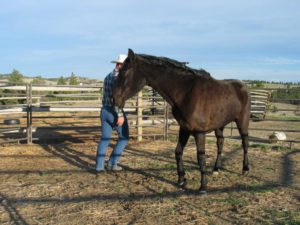 |
Notice how this filly’s body head and neck are beginning to arc and flex as she picks up her nearside hind and offside front. |
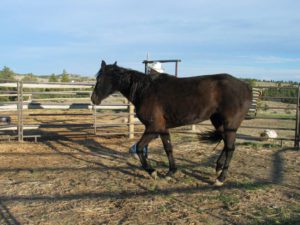 |
As she disengages her hindquarters, her foot placement has changed. Offside hind is picking up to cross away from me as the nearside front is picking up to cross over toward me. |
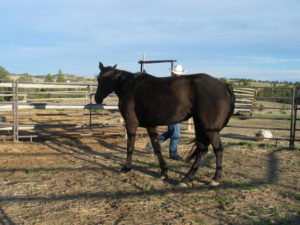 |
The nearside front has stepped in front of the offside front to move toward me. The body, head and neck are arced toward me as the offside hind is fully crossed over disengaging the hind quarters away from me. |
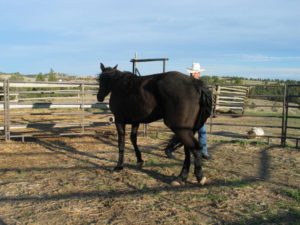 |
Offside front is lifting and moving toward me as the nearside hind is again picked up and crossing over as in the first picture. Body is still arced as hinds continue to move away and fores move toward me. |
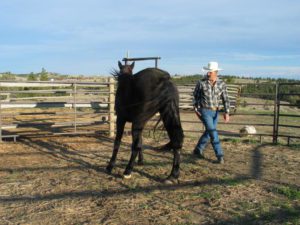 |
Notice how she is leaning toward me with the front of her body (engaging) to the extent it causes torque on the offside hind. She will lift the offside hind and place it away from me as she continues to disengage with the hinds. |
These are really the same overall techniques people use in different disciplines. There are some differences due to how they are taught or the application, but none the less the final achievement is the same; use your mind to influence your emotion and body to accomplish a certain task exactly as you wish it to be done.
There are several different descriptions as to what this is called. I’ve heard it referred to as both biofeedback and visualization. Professional athletes, yoga enthusiasts, ballet aficionados and martial artists all use the power of the mind to visualize exactly what they want the outcome of their activity to be. Using these techniques to increase performance can make the difference between succeeding and failing in highly competitive circumstances.
I have said many times that anyone who handles a horse is a horse trainer. This is true whether they believe it or not. The horse certainly is influenced by the handler even if the handler is unaware of it. Only three possible outcomes can come from someone handling a horse. Either they influence the horse to behave positively, nothing new is taught (training maintained), or it is influenced (allowed) to behave negatively. Often the negative training is done without the awareness of the handler at all. Very often the behavior the horse has is influenced by the handler being out of control of his / her emotions or not aware of what their emotions are projecting. If we are aware how we influence horse behavior by controlling our emotional energy; we can give the horse the emotional support it needs for increased performance and a better relationship.
When working with horses, you must have constant awareness of all the possible dangers involved with them. If you don’t, you could put yourself into a situation where death is the outcome. With that said, I am diligent about visualizing what I want the horse to do and do well. I think about this and control my emotions and expect it to happen. The overwhelming majority of the time it does. This holds true whether I am training a new horse or riding an older one. The horse is still reflective of me and my emotions regardless of age or training.
Do I ever get scared when training? I would be lying if I said no. What I do however is recognize the fear for what it is and not let it affect my emotional state or influence my body movement. I continue to control my thoughts, emotion and therefore behavior to influence the horses’ emotion and behavior in a desirable direction.
If I were to expect a horse to be nervous and jumpy every time I am around it, it will behave just as I ask. I would be projecting what I expect of the horse and the horse will read me in kind and give me what I want. It’s that simple.
It is so important to know exactly what you expect the horse to do and exactly what your emotional state is. The mixed or unclear emotional energy we sometimes carry within ourselves will be communicated.
Be aware what you really are asking for…the horse is very willing to give it to you.


